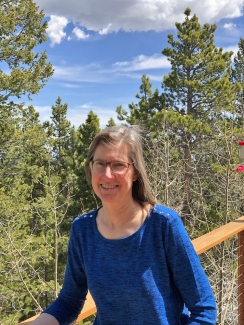Evelyn Grell’s story begins in a suburb of Philadelphia, PA where she was raised. Her interest in weather was inspired from spending time with grandparents on the Jersey shore. Her grandfather was an avid sailor and even built his own sailboat. Naturally, monitoring the weather and especially the wind direction was essential before setting sail.
Evelyn never seriously considered meteorology as a career until she was obliged to take a meteorology course in college for her undergraduate degree in Earth and Environmental Sciences. Understanding the ever-changing weather through the lens of physical laws had great appeal. Riding the momentum of this new passion, she earned a master’s degree in meteorology at The Pennsylvania State University, where she was introduced to numerical weather prediction. This was during the 1980s when an active partnership was in place between Penn State and NCAR in NWP work, thanks to the pioneering work of Richard Anthes, Thomas Warner, Nelson Seaman and others, in developing the Penn State/NCAR model, which evolved into MM3, MM4, and finally MM5. That model was a predecessor to the Weather Research and Forecasting model (WRF). Thanks to this connection, she landed a position right out of school, working on a collaborative project between NCAR and NOAA, applying modeling to investigate the potential impact of the new (at the time) wind-profiler network on weather prediction.
After nine years at NOAA, her meteorological career took a long hiatus when she and her German husband Georg decided to try living in Germany. Georg promptly found a job there and Evelyn was able to spend time at home with their two young sons. That was certainly not without challenges, as she knew very little German at first, so she endured some feelings of isolation throughout this period. However, they were fortunate to live in a spectacularly beautiful area at the foot of the Alps, and eventually made lifelong friends there. After four years, they decided to return to the Boulder area where Georg accepted an opportunity at NOAA/CIRES. Evelyn worked in the local elementary school for a couple of years until a meteorology opportunity knocked.
Currently, Evelyn’s work involves testing and evaluation of various model physics parameterizations in the single-column and regional versions of the UFS model and WRF. Typical tasks include running the model, implementing some changes, then running it again, and analyzing the results to determine the impact of the change.
Evelyn has divided her time between two different DTC projects. The HWRF Physics Advancement project focused on evaluating physics changes in the Hurricane WRF model, specifically the convection parameterization. That project was both interesting and challenging because it offered insight into elements of a complicated cycled model system that she had never dealt with before.
She currently belongs to the Physics Across Scales/Planetary Boundary Layer Team, which is assessing the performance of two operational physics suites across spatiotemporal scales in an effort to evaluate whether these suites can be applied across the broad range of scales needed for our operational models. This team is also examining potential causes of observed biases in the model boundary layer.
Collaborating on these DTC projects has offered her the opportunity to interact with some exceptionally bright people, and to learn new skills and new approaches for improving operational weather prediction.
Evelyn enjoys hiking, reading, puzzles, cross-country skiing, and she and her husband are looking forward to traveling the world when the pandemic is no longer a concern.
